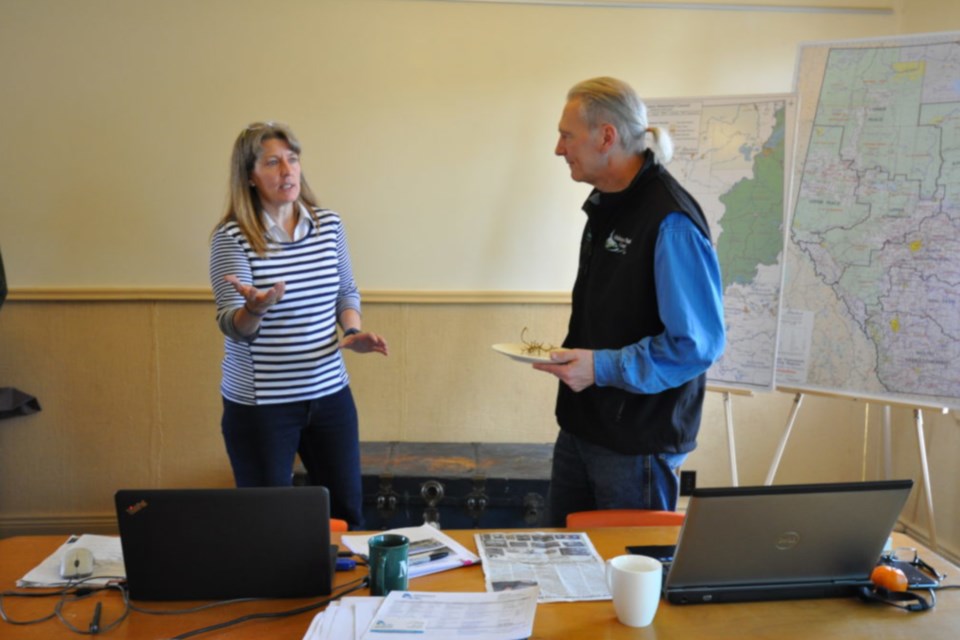ATHABASCA — The Athabasca Watershed Council (AWC) has faced some challenges over the last few months, but a new executive director is ready to take on the role and steer the Watershed Planning Advisory Council (WPAC) back on course.
Petra Rowell takes over as executive director from Janet Pomeroy who retired from the position at the end of December just as the AWC is in the midst of a suspension with Alberta Registries over a dispute including lack of access to the membership list which is given in the bylaws and a serious allegation that the latest version of the bylaws adopted in a 2020 online vote has not met the standard for votes required to replace the former bylaws.
It is a complicated web, but Rowell is focused on the work and engaging every person sitting around the table to get the organization back on track.
“Every multi-sector, multi-stakeholder group has its different personalities, different consensus,” Rowell said in a Feb. 26 interview. “I don't think there's a partnership out there that doesn't have challenges and I don't think I'm going to be too slowed down by that; I think we're going to just charge ahead. We've got lots of programs in the works.”
Rowell has a Bachelor of Science from the University of Alberta in biology, becoming a wildlife biologist focusing on bird biology, or ornithology, banding song birds and working on a Peregrine falcon release program before getting involved in land and water stewardship.
“So, about 2003 I was hired by Alberta Environment to work on the Water for Life strategy and in particular on the partnership side,” she said. "If you pick up the Water for Life strategy it has a component to engage Albertans in water management across the province. They created a provincial Alberta water council, and then these regional WPACs — watershed planning and advisory councils.”
It was in 2009 Rowell helped set up the Athabasca Watershed Council which is steward to the longest un-dammed river in Alberta, second in total length to the Peace River, and the riparian — the area between where the water ends and dry land flora begins.
“I just find water is really interesting because it engages everybody,” Rowell said. “You can go out and talk about different aspects of wildlife or different aspects of the environment, maybe air quality or something, but if you bring up water you get everybody to the table. Everybody needs it, everybody cares about it, everybody impacts it in one way or another.”
And getting those people to the table, then implementing what they decide to do is the other part of her job she is looking forward to.
“It's a really democratic process and that's hard too. I mean, it's not a short process, it takes a long time to come to consensus, but when you're done, man, have you ever got something powerful if you have everybody agreeing to it,” she said. “So, if you've got oil and gas and forestry and municipalities and environmental groups, and I'm not sure who I'm missing, but if you get all of those interests at the table and they agreed to something and go away and implement it, it's got a really good chance of having some staying power.”
Staying power, she notes is prevalent in the longevity of the Water for Life strategy.
"The Government of Alberta did really good consultations when Water for Life was being done and they got really good agreement on it,” said Rowell. “And I think that's shown today because it was released in 2003 so, here we are 18 years later, it's still out there as sort of the overarching approach of the government of Alberta to water management in the province.”
And while the troubles among the board swirl in the background, Rowell is focused on upcoming projects like possible fencing and off-site watering systems to keep livestock from destroying riparian areas, education, and a couple of benthic zone invertebrate studies.
“In the headwaters of the Athabasca (River) we're doing a benthic invertebrate program,” she said. “So, benthic invertebrates are those things like mayflies and caddisflies and stone flies, little things that are in the bottom of (bodies of water) and you can monitor those and looking at the different community makeup, you can relate it to water quality.”
Rowell said there are three overarching goals to watershed management — safe, secure drinking water, healthy aquatic ecosystems and reliable supply.
"So, do we have reliable supplies for the economy in the Athabasca and that is becoming more and more important as we think about climate change and what that's doing to our headwaters and our glacier waters all the way downstream,” said Rowell. “And also, that includes working with municipalities around drought management plans, being sort of prepared for all flood and drought.”
The State of the Watershed is available on the AWC website and Rowell hopes to get public input this summer but, in the meantime, she is working remotely, as most are during the pandemic, and will be hosting a “Have ‘coffee’ with AWC’s new Executive Director” on Zoom March 12 from 10 to 11 a.m.
To read the document or get the Zoom link to meet Rowell go to the AWC website at https://awc-wpac.ca/.


